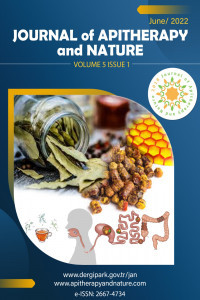The Impact of Honeybee Origin on the Quality of Propolis
The Impact of Honeybee Origin on the Quality of Propolis
Honeybee, Propolis, Honeybee origin,
___
- 1. Bankova VS, De Castro SL, Marcucci MC (2000) Propolis: recent advances in chemistry and plant origin. Apidologie 31: 3-15.
- 2. Falcão SI, Tomás A, Vale N, Gomes P, Freire C, Vilas-Boas M (2013) Phenolic quantification and botanical origin of Portuguese propolis. Industrial Crops and Products 396: 887-897.
- Yayın Aralığı: Yılda 2 Sayı
- Başlangıç: 2018
- Yayıncı: Oktay YILDIZ
Anticancer Properties of Aqueous and Nonaqueous Propolis Extracts
Zbigniev BALION, Aistė JEKABSONE, Kristina RAMANAUSKIENE, Daiva MAJIENĖ
Chemical Profiling of Tropical Propolis: Challenges and New Data
Milana POPOVA, Boryana TRUSHEVA, Kristina GEORGIEVA, Vassya BANKOVA
The Effect of Propolis on Selected Blood Parameters of Broilers
İvan MISKULIN, İvana KLARIC, Matija DOMACINOVIC, Berislav PRAKATUR, Zvonimir STEINER, Vatroslav SERIC, Maja MISKULIN
İbrahim PALABIYIK, Didem SOZERI ATIK, Esra BOLUK, Sevgi KOLAYLI
The Impact of Honeybee Origin on the Quality of Propolis
Gomes da Silva CAHANGO, Soraia I. FALCÃO, Miguel VILAS-BOAS
Antituberculosis Activity of Propolis
Jarosław WIDELSKI, Joanna GOLUS, Piotr OKIŃCZYC, Rafał SAWICKI, Grażyna GINALSKA, Tomasz MROCZEK, Zuriyadda SAKIPOVA, İoanna CHINOU, Krystyna SKALICKA-WOŹNIAK
İsamara Julia CAMURI, Adriano Batista COSTA, Wallance Moreira PAZIN, Amando Siuiti ITO
ARC (Apiceutical Research Centre): Exploring a New Generation of Medicines from the Beehive
Y. FRIÓN-HERRERA, D. GABBIA, M. CARRARA
The Efficacy of Propolis Fluoride in Inhibiting Dental Caries Activity on Primary Teeth
Risqa Rina DARWITA, Iwany AMALLIAH, Sri Angky SOEKANTO, Muhamad SAHLAN
